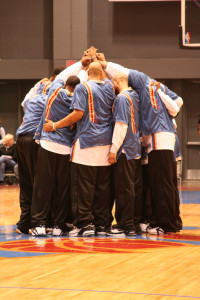Basketball Coaching and Creating a Positive Environment

When Basketball Coaching there is always rhetoric about creating a positive environment. But what does that mean? For many coaches involved with basketball coaching the limits of a positive environment extend to them using the sandwich technique when they are proving constructive feedback to players. The reality is however that in creating a positive environment there are a number of different strategies coaches can adopt.
Part of building a positive environment starting with the act of basketball coaching itself. When passing on directions to players coaches can adopt one of two strategies. These are either praise or encouragement. Praise refers to when a player has achieved an accomplishment and affirmative feedback is provided in light of this triumph. Encouragement however focuses of the provision of a supportive comment when a player has attempted, but failed or reached their expectations. Comments during these times should help centre the focus of the player back onto the task and inspire them to try again.
Another strategy a coach can have direct control over is in the selection of scenarios under which drills are completed or fulfilled. Adversity is a part of any good drill selection as it pushes the players within to test and ultimately redefine what their best efforts have previously been. The problem however is that often the fine balance through success and failure is not well thought out or planned. What this means is that if players endure too many unsuccessful outcomes during a training session for example, they can become demotivated and then sub-performance is only a moment away from being a reality. The best tactic is to have a balance between successful outcomes and those used to challenge and motivate players to reach new heights.
One other option for building a positive environment is to focus on the type of communication a coach utilises with the team. When basketball coaching there is sometimes a tendency to substitute motivating players with emotive statements that often do not benefit the players, staff or team. When involved in basketball coaching both during training sessions or games it is important for Head Coaches, Assistant Coaches and all staff to ensure that they maintain a calm and even temperament.
Basketball coaching can be a very challenging exercise because of some many different tasks to keep an eye on. By having a number of different staff available for training and games will assist in lightening this load and therefore reducing the possible stress placed upon one person, the Head Coach. By ensuring there is adequately capable staff around a coach this will help reduce the pressure on any one person.
The added bonus of the having additional staff involved with a team is the ability to multi-task player management activities. At any one time, a Head Coach can be involved in leading team activities on the floor, while Assistant Coaches are involved in providing one on one feedback while drills are being conducted. These roles can of course be reversed, depending on the intentions of the coach for each activity and what they see as the strengths within each of their staff. This strategy helps with the building of relationships between the coaching staff and players. This has any number of different positive benefits, but one will definitely be that players will become more resilient in their ability to handle adversity.
A positive environment can help improve a coach’s performance as much as the players. The resilience that often comes from a positive and enjoyable environment can help prevent a number of problems that often pop up when the atmosphere within a team is less than perfect.







